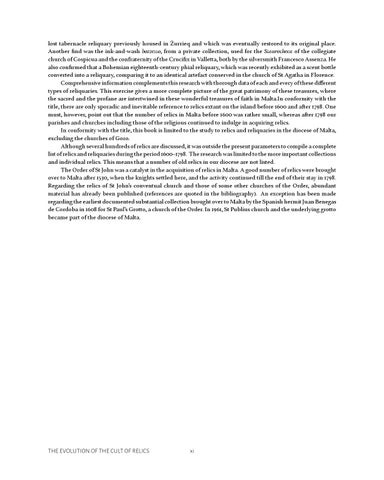lost tabernacle reliquary previously housed in Żurrieq and which was eventually restored to its original place. Another find was the ink-and-wash bozzetto, from a private collection, used for the Staurotheca of the collegiate church of Cospicua and the confraternity of the Crucifix in Valletta, both by the silversmith Francesco Assenza. He also confirmed that a Bohemian eighteenth-century phial reliquary, which was recently exhibited as a scent bottle converted into a reliquary, comparing it to an identical artefact conserved in the church of St Agatha in Florence. Comprehensive information complements this research with thorough data of each and every of these different types of reliquaries. This exercise gives a more complete picture of the great patrimony of these treasures, where the sacred and the profane are intertwined in these wonderful treasures of faith in Malta.In conformity with the title, there are only sporadic and inevitable reference to relics extant on the island before 1600 and after 1798. One must, however, point out that the number of relics in Malta before 1600 was rather small, whereas after 1798 our parishes and churches including those of the religious continued to indulge in acquiring relics. In conformity with the title, this book is limited to the study to relics and reliquaries in the diocese of Malta, excluding the churches of Gozo. Although several hundreds of relics are discussed, it was outside the present parameters to compile a complete list of relics and reliquaries during the period 1600–1798. The research was limited to the more important collections and individual relics. This means that a number of old relics in our diocese are not listed. The Order of St John was a catalyst in the acquisition of relics in Malta. A good number of relics were brought over to Malta after 1530, when the knights settled here, and the activity continued till the end of their stay in 1798. Regarding the relics of St John’s conventual church and those of some other churches of the Order, abundant material has already been published (references are quoted in the bibliography). An exception has been made regarding the earliest documented substantial collection brought over to Malta by the Spanish hermit Juan Benegas de Cordoba in 1608 for St Paul’s Grotto, a church of the Order. In 1961, St Publius church and the underlying grotto became part of the diocese of Malta.
THE EVOLUTION OF THE CULT OF RELICS
xi
